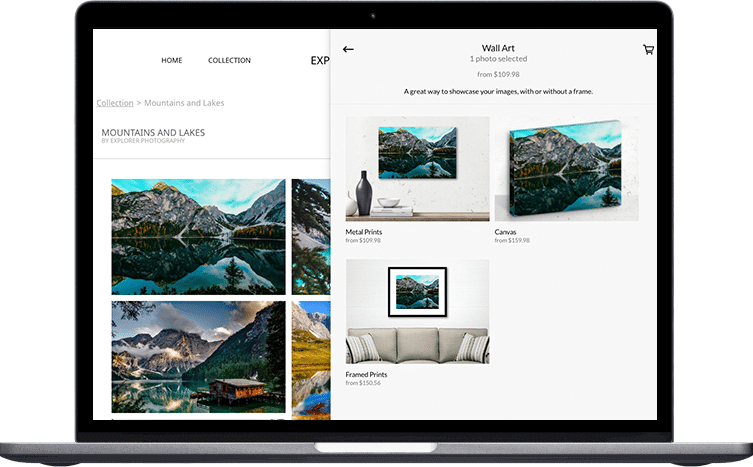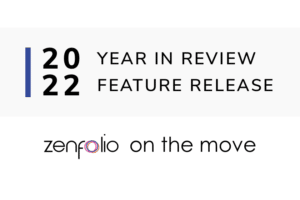15 key features photographers must have in an e-commerce platform.
September 8th, 2023
As a photographer, it’s not enough to make good art; you also need to learn how to sell your art properly. Hence, in this dynamic world of photography, e-commerce is more than a trend—it’s a pathway to success.
In fact, in this digital age, a good e-commerce platform is a game-changer. It will help you showcase your artistry and expertise, reach a global audience, tap into a diverse market of art enthusiasts and potential clients, and build a thriving business.
To this end, we’ll examine the concept and prospects of e-commerce platforms for photographers, key factors to look out for when choosing one, and key features every photographer must have in an e-commerce platform.
Understanding e-commerce for photographers.
E-commerce for photographers is the use of online platforms and digital technology to buy and sell photography-related goods and services. It’s like having a virtual store on the internet where photographers can display their work and connect with customers.
How does e-commerce help photographers?
1. Cost-effectiveness.
E-commerce platforms provide a digital storefront for photographers to showcase their portfolios, set prices for their works, manage orders, and process payments seamlessly—all at little cost. As well, online stores are easier and less expensive to run compared to physical stores.
2. 24/7 availability.
E-commerce platforms operate 24 hours a day, 7 days a week. This uninterrupted availability means that customers can peruse a photographer’s online store and make purchases at their convenience—regardless of time zones or holidays. This makes the business highly efficient and responsive to customers’ needs.
3. Global reach.
Unlike traditional stores confined to a specific location, e-commerce platforms help photographers display their work and interact with potential customers from all parts of the world.
This worldwide reach is especially beneficial for photographers who specialize in unique styles, as they can find a global niche market that appreciates their work.
4. Diversification of revenue.
Through e-commerce, photographers can sell digital copies of their photos and offer diverse photography services like photoshoots, event coverage, prints, and canvasses. Those getting into photo education can also offer photography workshops and courses.
What’s more, you can even sell photography-related merchandise, like camera cleaning kits, camera bags, photography books, and photography-themed accessories.
5. Easy portfolio management.
Showcasing your portfolio is essential for displaying your unique styles, skills, and expertise, and attracting customers. E-commerce platforms, like Zenfolio, make this easy with customizable templates and tools that help photographers create captivating portfolios and photo galleries.
Photographers can even present their works in different categories so customers can easily explore specific types of photos or themes. Plus, they can update their portfolio regularly, share their newest projects, and keep their content fresh and exciting.
6. Direct communication with customers.
Having an online presence makes it easy for photographers to have direct, one-on-one communication with their customers through live chats, social media, forums, or email.
Connecting your social media account to your e-commerce website can help photographers convert prospective customers with easy accessibility to products, receive client feedback on products and services, and better understand their preferences through both communication and sales reports.
7. Data Analytics.
E-commerce platforms provide valuable data analytics that offer insights into an online store’s performance. As such, you can keep track of metrics like website traffic, conversion rates, most popular products, and customer demographics.
By analyzing this data, you can make data-driven decisions to improve marketing strategies and overall customer experience.
8. Protection.
E-commerce platforms often include features like watermarking, data privacy, licensing options, and copyright information to protect photographers’ images from theft and unauthorized use.

8 Key factors to consider when choosing an e-commerce platform.
Going the e-commerce way can have significant impacts—and profits—for your business. However, the success of your platform hinges heavily on the relevance and functionality of the e-commerce development company you choose. So, it’s important to choose the right platform.
Choosing the right e-commerce platform for your needs isn’t as easy as it seems; these days there are many options available, like Zenfolio, Format, Weebly, SmugMug, and many others. To help you decide, keep this in mind: the right e-commerce platform will meet your requirements and help you achieve your goals.
With the countless e-commerce platforms out there, what are the key factors photographers need to consider before choosing an e-commerce platform?
1. Pricing
The first factor you should consider when choosing an e-commerce platform is the price. Most platforms offer monthly and annual subscription plans with varying features, and the prices will vary depending on your chosen platform and its features.
Look closely at what is included, then choose a platform that both accommodates your business’s specific needs and best fits your budget.
2. Business goals and objectives.
There are various platforms available, ranging from open-source to hosted, self-hosted, mobile, B2B, and custom-built. Before choosing an e-commerce platform, consider your business goals and objectives. Once you understand those needs clearly, choose a platform that aligns with them.
3. Available themes and customization options.
When choosing an e-commerce platform, consider the themes and customization options available. Your theme selection should align with your style and aesthetic preferences, as they set the tone for your online store’s visual identity and branding.
Plus, with a modern and visually appealing e-commerce template, your business will stand out from the crowd and impress customers.
Check the ease of customizing themes to match your unique styles and needs. Look out for a user-friendly customization process, like drag-and-drop editors, that’ll make it easy to change fonts, colors, layouts, and other design elements.
Thankfully, Zenfolio offers customizable templates and layouts that help photographers showcase their images in a captivating manner. It also has various design options which make it easy to create portfolios that align with photographers’ unique styles.
4. Security
Security should be a top priority when choosing an e-commerce platform. As an online vendor, you’ll be handling sensitive customer details, like personal information and payment data, so you need a platform that prioritizes security.
Look for platforms that provide robust security infrastructure, like 2 Factor Authentication, HTTPS/SSL encryption, a secure hosting environment, user access control, and compliance with industry standards like PCI DSS (Payment Card Industry Data Security Standard). Also, ensure the platform adheres to data protection and privacy regulations.
5. SEO-friendliness.
The best platforms also prioritize SEO (Search Engine Optimization), which can drive organic traffic to your online store. Look for features like image alt text, meta tags, customizable URLs, optimizable product descriptions, and content for search engines.
6. Scalability
Scalability is an important feature to look out for before choosing an e-commerce platform. The aim of starting a business is to make a profit and grow. And as your business expands and attracts more customers, you’ll need a platform that can handle a significant volume of orders and heavy website traffic, without compromising functionality or performance.
Also, look for an e-commerce platform that’ll let you upgrade resources, such as data storage and lab integration options, to meet your business’s growing demands. It should also support integrating additional features and third-party services to meet your evolving needs.
7. Integration and plugins.
Another feature to consider when choosing e-commerce platforms is integration options. A good e-commerce platform will have various integration capabilities with third-party tools, or include the ability to manage them within the platform. Here are some of those to look out for:
- Email marketing tools to stay in contact with customers and potential clients.
- Accounting plugins to help with sales, profits, and taxes.
- Apps that help with shipping products and tracking deliveries.
- Product management software to organize and list products, set pricing, and take inventory.
- Analytical tools to collect, process, and analyze data and provide valuable metrics.
8. Technical support.
If you’re just starting out in e-commerce, technical support is invaluable for your business. You’ll lose business if your customers can’t access your site, view your portfolio, or make payments. So, you must look for an e-commerce platform offering technical support.
More than that, it’s important to consider the type of support they’re offering. Some platforms only offer support on weekdays during business hours in their time zone, while others offer 24/7 support. Some only offer support via email while some also include live chat options.
Some platforms determine the level of support your business receives by the subscription plan you choose, so we recommend doing some research to ensure that you’ll have the support you need when you need it.

15 key features photographers must have in an e-commerce platform.
Here are 15 essential features every photography e-commerce platform must have:
1. High-quality image display.
A photographer’s e-commerce success relies heavily on the quality of images displayed. Top-notch image display will create a solid first impression on potential customers, demonstrating your professionalism and expertise and, in turn, attracting their attention.
Further, photography is a form of visual storytelling, and a platform that excels in image display elevates that narrative. Hence, your e-commerce platform must present photos of your craft in captivating ways that convey the photos’ stories effectively, appealing to the emotions of potential customers.
In addition, your platform must optimize images for different screen sizes and resolutions, load images fast, and be easy to navigate. When customers can see stunning, well-presented images of your craft, they’ll feel confident trusting your expertise and making purchases.
2. Simple navigation.
Another critical feature your e-commerce platform must have is a simple, easy-to-use interface. When potential customers can navigate your site effortlessly, they’re more likely to stay engaged, explore your work, and even make a purchase.
Thankfully, Zenfolio offers a user-friendly interface with simple navigation features.
3. Social media integration.
Social media is a powerful tool for photographers to market their work and interact with their audience and potential buyers. Hence, social media integration is an essential feature any photographer’s e-commerce platform must have.
With social media integration, you can easily connect your online store to various online platforms, expanding your reach and promoting your work to a larger audience. Social media integration also allows photographers to engage their audience, receive feedback on their products and services, and build a community around their brand.
4. Effective SEO tools.
SEO (Search Engine Optimization) is the process of optimizing a website and its content to boost its visibility in search engine results, making it more likely to be found by users searching for relevant topics or keywords. SEO aims to attract organic (i.e., non-paid) traffic to a website, increase its search page ranking, and ultimately increase its chances of reaching a wider audience.
Photographers can use effective SEO strategies to improve their online visibility, making it easier for potential clients to find their store through search engines like Google, Bing, and Yahoo. How?
- By conducting keyword research and using relevant keywords in their website’s content, photographers can target specific words or phrases that potential clients are likely to use when searching for photos or photography services.
- Photographers can optimize their website’s meta tags, titles, descriptions, and alt text to provide search engines with simple and relevant information about their photos and store. This helps search engines understand the site’s content, index it appropriately, and rank it accordingly.
- SEO encourages creating high-quality, relevant, and valuable content that engages readers and appeals to search engines. Photographers can attract and keep visitors by publishing captivating photo galleries, informative pages, and engaging blog posts, encouraging them to spend more time on their website. Thus, positively impacting search engine rankings.
Zenfolio’s e-commerce platform offers effective SEO tools and optimized templates. This makes it an excellent choice for photographers seeking to optimize their online store, attract more clients, and see more conversions.
5. Quick and secure payment options.
Another must-have feature for a photographer’s e-commerce platform is a variety of payment methods, which can include credit cards, debit cards, bank transfers, digital wallets, and even cryptocurrency.
When customers have multiple payment options, they can complete transactions seamlessly with the option they’re most comfortable with. This flexibility will satisfy customers and reduce the prospect of abandoning their carts during the checkout process.
Also, customers need to be convinced that their financial information is safe when making online purchases. By offering secure payment options, photographers can establish trust with their customers and encourage them to shop again.
What’s more? With Zenfolio’s integration of various reliable payment options, like Apple Pay, Google Pay, credit cards, and PayPal, photographers can provide their customers with a quick, safe, and seamless purchasing process.
6. Mobile responsiveness.
Around 2 billion people access the internet through their smartphones every day. Hence, smooth and impeccable mobile responsiveness is vital for a photographer’s e-commerce platform. When a website works seamlessly on all devices, including smartphones and tablets, it’ll give potential customers a positive user experience.
A mobile-friendly platform resolves issues like slow loading and distorted layouts, making it easy for visitors to browse through a photographer’s website. Also, with quick and responsive pages, potential customers are more likely to remain engaged and explore a photographer’s work further.
7. Analytics and sales reports.
Having data to track website performance is an essential feature for photographers on e-commerce platforms. With analytics, photographers can gain valuable insights into their website’s performance and customer behavior.
This data will help them understand their most popular products, which marketing strategies are effective, and what areas may need improvement. With data-driven insights, photographers can optimize their online store and marketing strategies effectively, increasing their chances of sales and success.
Sales reports, on the other hand, will provide an extensive breakdown of the photographer’s revenue and customer transactions. This information will help track the business’s growth over time, identify peak sales periods, and analyze the impacts of discounts or promotions.
By tracking the impact of promotional efforts, photographers can work on better marketing tactics for more effective campaigns.
8. Batch upload and pricing.
The ease of uploading and pricing multiple photos at once is a game-changer for photographers using e-commerce platforms. With batch upload features, they can save time and effort by uploading many images at the same time. This makes it easier to add new content to their client galleries or online store.
Also, batch pricing features help photographers set prices for multiple images in one go. Instead of individually pricing each image, they can apply bulk pricing options. This not only speeds up the pricing process but also ensures that prices are accurate and organized for clients.
9. Watermarking features.
A watermarking feature is a vital tool for photographers to protect their images against unauthorized use and theft.
Watermarking also serves as a means of attribution, ensuring that viewers recognize the original owner of an image. If the watermarked image is distributed without permission, the photographer’s identity remains intact.
Plus, with the watermarking feature, photographers can confidently showcase their images online, knowing that their intellectual property is safe.
For example, Zenfolio’s watermarking options allow for custom watermarks to be uploaded. This gives photographers an added layer of security and protection from their work being stolen or used without permission.
10. Customizable digital download options.
Customizable digital download options are features that allow photographers to determine the specifications of the digital photos they want to offer clients for purchase.
With customizable digital download options, photographers can cater to their customers’ specific preferences, or even offer set amounts of “free” files that may have been included in service packages. Also, when customers can choose their preferred resolutions and specifications for printing, social media sharing, or web use, they get the best-suited version of the image for their particular purpose.
Offering appropriate download options for your clients demonstrates a photographer’s commitment to delivering quality products and meeting their customers’ specific needs. It also gives customers a sense of control over their purchases, making them more likely to return for more.
11. Print fulfillment integration.
Print fulfillment integration is a feature that connects a photographer’s e-commerce platform directly with a professional printing lab. It automates the process of printing and shipping orders, letting photographers offer an extensive array of print options without needing to handle production, shipping, and fulfillment manually.
Zenfolio partners with print labs around the world to integrate their products into the Zenfolio system. This helps photographers offer their products for sale to customers through their site. And when an order is placed, the system handles the order and payment collection, while the lab handles the order fulfillment (receiving, packing, and shipping).
12. Built-in blogging feature.
A built-in blogging feature is vital for photographers on e-commerce platforms because it helps them share their stories and interact with their audience. With this feature, photographers can seamlessly write and publish blog posts on their online portfolio website and e-commerce platform.
By dishing out valuable and engaging content, photographers can connect with their audience on a more personal level, building a stronger community of followers and potential customers. Plus, regular blogging via this feature can improve the website’s search engine visibility.
13. Live chat support.
Live chat support is an essential feature for a photographer’s e-commerce platform, as it provides prompt assistance to photographers experiencing difficulties of any kind with their website. This instant support can help photographers find answers to questions, resolve potential issues quickly, and provide faster replies to their own clients when difficulties arise.
14. User-friendly interface for photographers.
A user-friendly interface for photographers is necessary for managing business operations with ease and efficiency.
For instance, a well-designed and easy-to-use backend interface will help photographers easily upload and organize their images, create galleries, and customize their website’s appearance. With this, they can showcase their work and make updates without needing technical expertise.
Also, a user-friendly backend will help photographers manage orders seamlessly, monitor customer information and comments, and generate sales reports.
15. Scalability
Scalability is an e-commerce platform’s ability to grow and evolve with a photographer’s business. It’s a critical feature for photographers looking for a long-term e-commerce solution that can accommodate their increasing customer base and expanding portfolio.
A scalable platform ensures that photographers can easily add and manage an increased number of new images, products, and content without sacrificing performance or customer experience. It can handle higher website traffic, sales volume, and data storage as the business grows without disrupting its functionality.
Plus, scalability helps photographers adapt to changing market trends and customer needs. They can introduce new features, marketing strategies, and pricing structures without needing to switch their e-commerce platform.
The bottom line: Unlocking your potential through e-commerce solutions.
The 15 vital features discussed above are crucial for building a successful photography e-commerce business. And as you consider various e-commerce platforms for your photography business, it’ll be in your best interest to review and assess them based on these features.
It might seem like a drag at first, but doing this will help you decide on the best platform that meets your needs.


